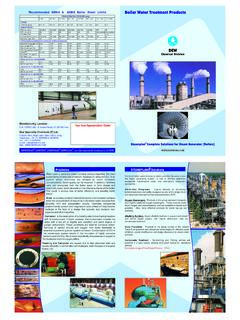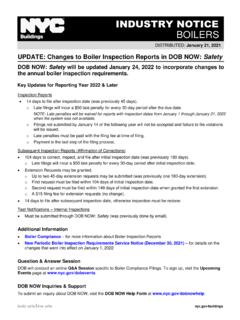Transcription of Boiler Drum Level Transmitter Calibration - Technical Note
1 Technical Note00840-0100-4360, Rev ABOctober POINTS Fluctuating water Level or changing rate of water inflow and steam outflow can cause measurement errors. Thermodynamics of pressure and temperature, geometry of the steam drum , and equation of continuity define Transmitter Calibration . Check the zero elevation and span against Transmitter specifications to ensure selected Transmitter can be calibrated to required OVERVIEWS team drum Level is both a critical and difficult measurement to make. Control of the water Level in the drum must be precise.
2 A water Level that is too high can result in water carryover into the steam piping. A Level that is too low can expose the generating tubes (down comers), preventing the water in the drum from cooling the furnace tubes, possibly damaging factors make this measurement difficult to obtain. The steam drum itself may not be perfectly Level , and even at steady state conditions, considerable turbulence in the drum can cause the Level to fluctuate. In addition, a changing rate of water inflow and steam outflow adds to the potential for measurement of Boiler steam drum Level using a differential pressure Transmitter must take into account certain physical properties of the fluid.
3 The Steam drum contains a two-phase mixture of water and steam at saturation conditions. The densities of water and steam vary with saturation temperature or pressure. The density of saturated steam above water must be considered, as well as the density of saturated water in the Technical note offers a method for calibrating transmitters that takes into account these 1 on page 2 shows a simplified sketch of the process. Note that Level , as we define it, is measured in units of length in this case, inches.
4 Differential pressure, on the other hand, is measured in inches of water column differential pressure. The two are sometimes confused, but do not refer to the same column of water one inch high under one set of operating conditions does not exert the same hydrostatic head pressure as a column of water of the same height under another set of conditions. The objective is to measure differential pressure and read it as a unit of drum Level Transmitter CalibrationTechnical Note00840-0100-4360, Rev ABOctober 20102 Figure 1.
5 Boiler Steam DrumThe steps necessary to define the Transmitter Calibration use the thermodynamic operating conditions of pressure and temperature, the geometry of the steam drum , and the equation of continuity. Note that this Calibration assumes only one set of operating conditions. In real practice, operating parameters change with Boiler load and other factors, such as ambient temperature. For that reason, three element feedwater control systems often require that the drum Level measurement be compensated for deviations from design operating drum pressure.
6 It is also convenient to know the drum Level during startup of the plant that is, from 0 psig to full operating pressure. This dynamic pressure and temperature compensation requires a separate computational first step in the Calibration is to define the process variables (shown in Figure 1):Po = Static pressure in the steam drum at the top tapPh = Static pressure at the high side of the transmitterPl = Static pressure at the low side of the Transmitter = Density of saturated steam at operating conditions= Density of saturated water at operating conditions= Density of water in the wet or reference legH = Distance between the high and low drum tapsh = drum water Level (measured from the bottom tap)hmax = Maximum water Level allowed (measured from the bottom tap)
7 Hmin =Minimum water Level allowed (measured from the bottom tap)= Center line of the steam drumV = Vertical distance from the bottom tap to the Transmitter s w oCLTechnical Note00840-0100-4360, Rev ABOctober 20103 SOLUTIONFrom the equation of continuity:Thus, This equation calculates the differential pressure on the Transmitter . The differential pressure is highest when the drum water Level is lowest, and the differential pressure is lowest when the Level is highest. Therefore, the Transmitter zero must be elevated so that an increasing Level results in an increasing output perform the Calibration , use a table of thermodynamic properties of steam and the following steps:1.
8 Determine hmin and hmax. These are the minimum and maximum water levels allowed for safe operation of the Boiler . They are measured from the bottom tap of the steam Using the saturated steam tables, find the values of and at the drum operating pressure. Use the value for compressed water in the reference (wet) leg at the expected ambient temperature and the drum operating pressure. If the compressed water table is not available, use the reciprocal of the specific volume of saturated water at the ambient temperature.
9 Since water is nearly incompressible, this provides reasonable accuracy for the drum For this example assume: The inside diameter of the steam drum is 60 in. H = 33 in. ( cm) Po = 2,425 psig (design operating pressure) Tambient = 105 F (41 C) hmin = in. ( cm) hmax = in. ( cm) The desired Level readout is 15 to 15 in. (a standard indicator faceplate range)4. Solve the equation:The specific volume of the saturated water at 2,425 psig is ft3/lb, = specific volume of the saturated steam at 2,425 psig is ft3/lb, = specific volume of the saturated water at 105 F is , = convert all units to consistent inches of water column, correct the above formula to reference conditions.
10 To do this, divide by .At hmin the Transmitter output will be 4mA dc. = [33( ) + ( )] = inH2 OThis is the required zero elevation of the hmax: ( Transmitter output will be 20 mA dc) = [33( ) + ( )] = inH2 OTherefore, the span of the = inH2O Differential PressureFinally, check the zero elevation and span against the Transmitter specifications to ensure the selected Transmitter can be calibrated to the required the drum Level Transmitter properly calibrated, the midpoint of the actual readout range, typically 15 to 15 in.


















